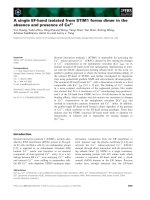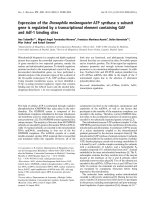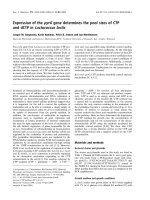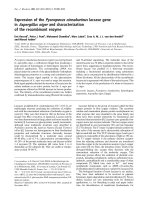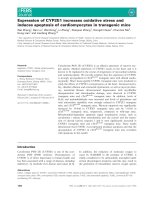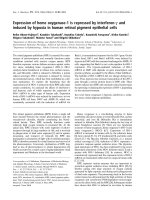Báo cáo khoa học: " Expression of cell surface receptors and oxidative metabolism modulation in the clinical continuum of sepsis" ppt
Bạn đang xem bản rút gọn của tài liệu. Xem và tải ngay bản đầy đủ của tài liệu tại đây (531 KB, 10 trang )
Open Access
Available online />Page 1 of 10
(page number not for citation purposes)
Vol 12 No 1
Research
Expression of cell surface receptors and oxidative metabolism
modulation in the clinical continuum of sepsis
Paulo S Martins
1
*, Milena KC Brunialti
1
*, Leandro SW Martos
1
, Flavia R Machado
2
,
Murillo S Assunçao
2
, Sergio Blecher
3
and Reinaldo Salomao
1
1
Division of Infectious Diseases, Escola Paulista de Medicina, Federal University of Sao Paulo, Brazil
2
Intensive Care Unit, Hospital Sao Paulo, Federal University of Sao Paulo, Brazil
3
Intensive Care Unit, Hospital Santa Marcelina, Sao Paulo, Brazil
* Contributed equally
Corresponding author: Reinaldo Salomao,
Received: 4 Oct 2007 Revisions requested: 14 Nov 2007 Revisions received: 21 Dec 2007 Accepted: 13 Feb 2008 Published: 13 Feb 2008
Critical Care 2008, 12:R25 (doi:10.1186/cc6801)
This article is online at: />© 2008 Martins et al.; licensee BioMed Central Ltd.
This is an open access article distributed under the terms of the Creative Commons Attribution License ( />),
which permits unrestricted use, distribution, and reproduction in any medium, provided the original work is properly cited.
Abstract
Background Infection control depends on adequate microbe
recognition and cell activation, yet inflammatory response may
lead to organ dysfunction in sepsis. The aims of this study were
to evaluate cell activation in the context of sepsis and its
correlation with organ dysfunction.
Methods A total of 41 patients were prospectively enrolled: 14
with sepsis, 12 with severe sepsis and 15 with septic shock. A
total of 17 healthy volunteers were included as a control group.
Patients were admitted to the Intensive Care Units and
Emergency Rooms of Hospital Sao Paulo (Federal University of
Sao Paulo) and Hospital Santa Marcelina, Sao Paulo, Brazil.
Toll-like receptor (TLR)2, TLR4, CD11b, CD11c and CD66b
expression on neutrophil surfaces and oxidative metabolism
measured by non-fluorescent dichlorofluorescein (DCFH)
oxidation in neutrophils and monocytes, using whole blood,
were evaluated using flow cytometry. Organ dysfunction was
measured using the sepsis-associated organ failure assessment
(SOFA) score.
Results TLR2 expression on neutrophils was found to be
downregulated in septic shock patients compared to healthy
volunteers (p = 0.05). No differences were found in CD11b and
CD11c expression. CD66b expression was increased in the
patient group compared to the control group (p = 0.01).
Neutrophil and monocyte oxidative burst was increased in septic
patients compared to the control group at baseline and after
stimulation with phorbol myristate acetate (PMA), formyl-
methionyl-leucyl-phenylalanine (fMLP), lipopolysaccharide
(LPS) and Staphylococcus aureus (p < 0.001 and p < 0.01,
respectively, for neutrophils and monocytes in all tested
conditions). A strong correlation was observed between
neutrophil and monocyte oxidative metabolism. A SOFA score
of 7 discriminated patients between survivors and non-survivors
(area under the curve for reactive oxygen species (ROS) was
0.78; p = 0.02). ROS generation in patients with sepsis and
septic shock with SOFA scores > 7 was higher than in patients
with SOFA scores < 7, both in neutrophils and monocytes.
However, oxidative burst in patients with sepsis was as high as
in septic shock.
Conclusion Surface receptors expression on neutrophils may
be modulated across the continuum of sepsis, and enhanced or
decreased expression may be found depending on the receptor
considered. ROS generation is upregulated both in neutrophils
and monocytes in septic patients, and it is differently modulated
depending on the stage of the disease and the stimuli used.
Introduction
Severe sepsis and septic shock present with high incidence,
morbidity and mortality, and are the most common causes of
death in intensive care units [1]. The overall mortality rate is
approximately 30%, rising to 50% or more in patients with the
more severe syndrome, septic shock, despite recent progress
in understanding its pathophysiology and improvements in
supportive intensive care [2].
AMP = antimicrobial peptide; DCFH-DA = 2',7'dichlorofluorescein diacetate; fMLP = formyl-methionyl-leucyl-phenylalanine; GM-CSF = granulocyte-
macrophage colony stimulating factor; GMFI = geometric mean fluorescence intensity; LPS = lipopolysaccharide; PAMPs = pathogen associated
molecular pattern; PMA = phorbol myristate acetate; PRR = pattern recognition receptor; RNS = reactive nitrogen species; ROS = reactive oxygen
species; RR = relative risk; SOFA = sepsis-associated organ failure assessment; TLR = toll-like receptor; TNFα = tumor necrosis factor alpha.
Critical Care Vol 12 No 1 Martins et al.
Page 2 of 10
(page number not for citation purposes)
The pathogenesis of sepsis involves a complex interaction
between host and infecting microorganism, including bacterial
recognition, cell activation and transmigration, phagocytosis
and destruction of the pathogen [3-6]. Bacterial recognition
and cellular activation are mainly driven by the interaction of
pathogen-associated molecular patterns (PAMPs) and the
pattern recognition receptors (PRRs), among them the Toll-
like receptors (TLRs) [7]. There is some specificity between
TLRs and microbial constituents, with TLR4 interacting with
lipopolysaccharide (LPS) from Gram-negative bacteria and
TLR2 with peptidoglican, lipoteicoic acid from Gram-positive
bacteria, lipoproteins from mycobacteria, and others [8,9]. To
date, a broad recognition of microbial products by many TLRs
has been verified [10]. Current data demonstrate that TLR2
and TLR4 are expressed on the cell surface of neutrophils from
healthy volunteers and are upregulated after stimulation by
LPS [11] or granulocyte-macrophage colony stimulating factor
(GM-CSF) [12]. Moreover, the generation of reactive oxygen
species can be triggered through TLRs [13]. Thus, the evalu-
ation of TLRs expression on neutrophils and monocytes in sep-
sis is of increasing interest.
Once primed by bacterial products and endogenous media-
tors [14-16], neutrophils adhere to activated cells in inflamed
tissues and transmigrate through the endothelial cells to
phagocytose and destroy the pathogens [17]. CD66 is a glyc-
oprotein expressed on neutrophils that mediates the interac-
tion with endothelial surfaces triggering a transient activation
signal that regulates the adhesive activity of CD11/CD18
[18]. Firm adhesion involves the interaction of leukocyte
integrins of the beta 2 subfamily (CD11a, CD11b and CD11c)
with endothelial ligand receptors [19]. An increase in the
expression of those integrins on neutrophils, in particular
CD11b, is considered to be a good marker of cell activation
[20].
Invading pathogens are phagocytosed and killed through a
potent arsenal of enzymes, cationic proteins, reactive oxygen
species (ROS), reactive nitrogen species (RNS), and so on,
released into the phagosomes [21,22]. ROS generation in
phagocytes is dependent mainly on NADPH-oxidase, a mem-
brane-bound multi-component enzyme complex that once acti-
vated works as the electron donor and converts molecular
oxygen to its one-electron reduced product, the superoxide
anion (O
2
-
), which is in turn converted to hydrogen peroxide
(H
2
O
2
) through a reaction catalyzed by superoxide dismutase.
In turn, H
2
O
2
is a substrate for the generation of other potent
oxidants [8,16,23].
ROS generation has been reported to be upregulated in neu-
trophils from septic patients compared to healthy volunteers
upon stimuli with bacterial products and components such as
LPS and formyl-methionyl-leucyl-phenylalanine (fMLP) [6,24].
Modulation of ROS production has not been evaluated in
monocytes of septic patients; however, they are known to be
hyporesponsive to LPS with regard to the production of inflam-
matory cytokines [25].
In the present study, we evaluated the expression of TLR2,
TLR4, CD11b, CD11c and CD66b on the cell surface of neu-
trophils in patients with sepsis, severe sepsis and septic
shock, and compared the findings with those from healthy vol-
unteers. We further evaluated neutrophil and monocyte activa-
tion through ROS production, and correlated cell activation
and organ dysfunction measured by the sepsis-associated
organ failure assessment (SOFA) score [26].
Materials and methods
Patients and healthy volunteers
The study population consisted of 41 patients admitted to the
Hospital Sao Paulo and Hospital Santa Marcelina, who met at
least three clinical criteria for sepsis (14 patients), severe sep-
sis (12 patients) and septic shock (15 patients) as previously
described by Bone et al. [27] and reviewed in 2001 by Levy et
al. [28]. Patients older than 18 years were enrolled within the
first 48 h of diagnosis or appearance of the first organ dysfunc-
tion or shock in sepsis, severe sepsis and septic shock,
respectively. Patients were excluded from the study if they
were infected with human immunodeficiency virus, had any
neoplasic disease, had received immunosuppressive medica-
tions, or if they were participating in any other study protocol.
Informed consent guidelines approved by the Ethical Commit-
tee of both participant hospitals were required, and obtained
from the patients themselves or from the responsible relative
in case of unfeasibility of the patient before enrollment in the
study.
The mean age and standard deviation of patients was 55.1 ±
20.2 years, and 69% were male. Infection was due to pneumo-
nia (48.7%), urinary tract infection (19.5%), peritonitis
(14.6%), bloodstream infection (9.7%) and/or other sources/
more than one source of infection (19.5%). Cultures were pos-
itive in 10 patients for the following microorganisms: Staphy-
lococcus aureus, Staphylococcus coagulase negative,
Escherichia coli, Providencia spp, Klebsiella sp, Proteus sp,
Acinetobacter and Enterococcus faecalis. A total of 60% of
the infections were due to Gram-negative microorganisms.
The 28-day mortality rate was 24.4% (10/41) and hospital
mortality was 36.6% (15/41). Comorbidities were present in
58.5% of the patients, the most found been hypertension, dia-
betes, congestive heart failure, chronic obstructive pulmonary
disease and chronic renal failure. Organ dysfunction was
assessed by the SOFA score and was evaluated at day 1 of
admission in the severe sepsis and septic shock groups. The
median SOFA score was 4.5 in severe sepsis, ranging from 1
to 12 in this group, and 8.5, ranging from 4 to 16, in the septic
shock group (p = 0.01). Demographic data, comorbidities,
SOFÁ score and outcome of septic patients are expressed in
Table 1. Finally, 17 healthy volunteers were included as normal
Available online />Page 3 of 10
(page number not for citation purposes)
controls. The mean age and standard deviation into this group
was 36.4 ± 16.1 years, and 30% were male.
Blood sampling
For blood samples, 5 ml of blood were drawn from both
healthy volunteers and septic patients into heparin-treated
vacuum tubes and 5 ml into ethylenediaminetetraacetic acid
(EDTA)-treated tubes (Becton Dickinson, Plymouth, England).
Flow cytometry analysis
The monoclonal antibodies used were as follows: CD66b-flu-
orescein isothiocyanate (FITC) clone G1OF5; CD11b-allo-
phycocyanin (APC) clone D12; CD11c-APC clone S-HCL-3
and isotype control mIgG2b-APC clone27-35, obtained from
BD Bioscience Pharmingen, San Diego, California, USA, and
TLR2-PE clone TL2.1; TLR4-PE clone HTA125 and isotype
control mIgG2a-PE clone MOPC-173 were obtained from
eBioscience (San Diego, CA, USA).
The expression of cell surface receptors was performed in
whole blood, drawn in EDTA tubes. A total of 100 μl of whole
blood from patients and controls were stained with 4 μl of
CD14-PerCP and 5 μl of CD66-FITC. The tubes were also
stained with the following isotypes: 10 μl of mIgG2a-PE and 2
μl of mIgG2b-APC (tube 1); 10 μl of TLR2-PE and 2 μl of
CD11c-APC (tube 2) or 20 μl of TLR4-PE and 2 μl of CD11b-
APC (tube 3). Samples were incubated with fluorochrome-
conjugated monoclonal antibodies for surface staining for 15
min in the dark at room temperature. Red blood cells were rup-
tured with 2 ml lysis solution (FACS lysing solution, BD Bio-
science) for 10 min in the dark at room temperature followed
by centrifugation at 2,500 g for 5 min at 4°C. Then, 2 ml of
phosphate-buffered saline (PBS) were added to each tube
and centrifuged. Supernatants were discarded and cells were
resuspended in 0.3 ml PBS/1% sodium azide.
Event acquisition and analyses were performed using the Cel-
lQuest software (BD Bioscience) in a FACSCalibur four-color
flow cytometer (BD Bioscience). For each condition 5,000
events were counted in forward- and side-scatter parameters
combined with CD14 positive cells. All events were acquired
and stored. Neutrophil analyses were performed using for-
ward- and side-scatter parameters combined with CD66b
positive and CD14 negative stained cells. The surface recep-
tor expression was measured as the geometric mean fluores-
cence intensity (GMFI), and results were expressed as the
difference between the fluorescence obtained with specific
antibodies and isotype controls.
Table 1
Demographic data, comorbidities, sepsis-associated organ failure assessment (SOFA) score and outcome from patients
Sepsis (n = 14) Severe sepsis (n = 12) Septic shock (n = 15)
Age, years (mean ± SD) 49.4 ± 19.2 58.4 ± 22.2 57.8 ± 18.9
Male % 78.5 58.3 60
Source of infection, %:
Pulmonary 42.9 58.3 40
Urinary tract 35.7 8.3
Peritonitis 25 26.6
Bloodstream 7.1 26.6
Others 14.3 8.3
Comorbidities Hypertension Hypertension Hypertension
Diabetes Diabetes Diabetes
CHF CHF CHF
COPD COPD COPD
CRF CRF CRF
CLF CLF CLF
Stroke
Median SOFA score (range) 4.5 (1–12) 8.5 (4–16)
28-day mortality, % 7 41.6 40
Hospital mortality, % 7 50 53.3
CHF, congestive heart failure; CLF, chronic liver failure; COPD, chronic obstructive pulmonary disease; CRF, chronic renal failure; SD, standard
deviation.
Critical Care Vol 12 No 1 Martins et al.
Page 4 of 10
(page number not for citation purposes)
ROS formation was assessed by using 1 ml aliquots of hepari-
nazed whole blood obtained from patients and healthy con-
trols. Oxidative burst was quantified by the addition of 0.06
mM of 2',7'-dichlorofluorescein diacetate (DCFH-DA) in 100
μL of whole blood. DCFH-DA is a stable, non-fluorescent, non-
polar compound that can diffuse through cell membranes.
Once inside the cell, the acetyl groups are cleaved by
cytosolic enzymes to form the polar non-fluorescent dichlo-
rofluorescein (DCFH), which is rapidly oxidized to highly fluo-
rescent 2',7'-dichlorofluorescein (DCF) in the presence of
hydrogen peroxide, thus providing an FL1 fluorescence semi-
quantitative assessment of the oxidative metabolism in individ-
ual granulocytes and monocytes using flow cytometry.
ROS production was measured constitutively and in response
to fMLP (10
5
M/ml, Sigma, St Louis, MO), phorbol myristate
acetate (PMA, 100 ng/ml, Sigma), LPS of Salmonella abortus
equii (500 ng/ml, kindly provided by Dr Chris Galanos, Max
Planck Institute of Immunobiology, Freiburg, Germany), and to
heat-killed S. aureus (2.4 × 10
9
colony-forming units/ml,
ATCC 25923; DIFCO, Detroit, MI, USA). Briefly, the tubes
from each sample were incubated in a 37°C shaking water
bath for 30 min. Thereafter, 2 ml of 3 mM EDTA (Sigma) was
added to each tube followed by centrifugation (250 g for 10
min at 25°C). Hypotonic lyses in 0.2% saline were performed
followed by addition of 1.6% saline and centrifugation (250 g
for 10 min at 25°C). The supernatants were discarded and the
pellets were once again incubated with 4 μL of CD14-PerCP
at room temperature for 15 min in the dark. Then, 2 ml of PBS
was added to each tube followed by centrifugation (250 g for
10 min at 25°C). The supernatants were discarded and the
pellets resuspended in 300 μL of 3 mM EDTA to flow cytomet-
ric analysis. For each measurement, cells were acquired based
on forward- and side-scatter characteristics and CD14
expression. Neutrophils were gated based on forward- and
side-scatter parameters and monocytes by combining these
parameters and CD14 expression. ROS generation was
expressed as the GMFI in FL1.
Statistical analysis
Variables were compared between the patient group and
healthy volunteers by Mann-Whitney test. Comparisons
among healthy volunteers, patients with sepsis, severe sepsis
and septic shock were performed by Kruskal-Wallis test. The
variables that showed differences among the four groups were
compared group to group by Mann-Whitney test. The correla-
tion between variables was analyzed by Pearson correlation
test. Area under the curve (ROC) was performed for the anal-
ysis of organ dysfunction assessed by the SOFA score. A p
value under 0.05 was considered as statistically significant.
The results were analyzed using SPSS software (version 13.0;
SPSS Inc., Chicago, IL, USA).
Results
TLR2 and TLR4 expression on neutrophil surface
There was no difference in TLR2 expression in the patient
group compared to the control group. The comparison among
the four groups showed a trend to significance (p = 0.08) with
lower TLR2 expression in the septic shock group compared to
the control group (p = 0.05), to the sepsis group (p = 0.03)
and severe sepsis group (p = 0.04). There was no difference
in TLR4 expression among the four groups (p = 0.297) (Figure
1A,B).
CD11b, CD11c and CD66b expression on neutrophil
surface
There were no differences in the expression of CD11b and
CD11c among the four groups (p = 0.45 and p = 0.34,
respectively) (Figure 1C,D).
The expression of CD66b was significantly higher in the
patient group (median GMFI of 84.1 varying from 26 to 175.3)
compared to the control group (median of 61.6 varying from
23.9 to 123.1) (p = 0.01). Additionally, the comparison among
the four groups showed a higher CD66b expression in the
severe sepsis and septic shock groups compared to healthy
volunteers (p = 0.02 and p = 0.01, respectively) (Figure 1E).
There was no correlation between the surface expression of
neutrophil inflammatory markers and the total white blood cell
count or absolute neutrophil count in these patients (data not
shown).
Neutrophil oxidative metabolism
ROS generation was enhanced in the patient group compared
to the control group constitutively and after PMA, fMLP, LPS
and S. aureus stimulation (p < 0.001 in all tested conditions).
The median GMFI and range values in the patient group and
control group at baseline and after diverse stimuli are shown
in Table 2.
The comparison among the four groups showed an increased
ROS formation at baseline and after diverse stimuli in all
groups of patients compared to healthy volunteers (p < 0.01),
except after PMA and fMLP stimuli in severe sepsis (p = 0.15
and p = 0.17, respectively). ROS generation was diminished
in severe sepsis compared to sepsis after stimulation with
PMA (p = 0.04) and to septic shock after LPS (p = 0.02) and
S. aureus (p = 0.04). ROS generation was higher in sepsis
compared to septic shock after stimulation with S. aureus (p
= 0.04) (Figure 2).
Monocyte oxidative metabolism
ROS generation was enhanced in monocytes from septic
patients compared to healthy volunteers at baseline and after
stimulation with PMA, fMLP, LPS and S. aureus (p < 0.01 in
all tested conditions). The median GMFI and range in the
Available online />Page 5 of 10
(page number not for citation purposes)
patient group and in the control group at baseline and after the
diverse stimuli are also shown in Table 2.
The comparison among the four groups showed an increased
ROS formation at baseline and after diverse stimuli in all
groups of patients compared to healthy volunteers (p < 0.01),
except after fMLP stimulation in sepsis and after PMA and
fMLP stimulation in severe sepsis (p = 0.17, p = 0.11 and
p = 0.96, respe ctively). ROS generation was diminished in
severe sepsis compared to sepsis after stimulation with LPS
(p = 0.01) and to septic shock after fMLP (0.03) and LPS
(p = 0.008) (Figure 3).
Correlation between neutrophil and monocyte oxidative
metabolism in septic patients
A strong correlation between neutrophil and monocyte oxida-
tive metabolism in septic patients was found at baseline
(R
2
= 0.62) and after stimuli with PMA (R
2
= 0,69), fMLP
(R
2
= 0,86), LPS (R
2
= 0,61) and S. aureus (R
2
= 0,64).
Results are shown in Figure 4.
Oxidative metab olism and organ dysfunction
Organ dysfunction was evaluated by the SOFA score in
patients with severe sepsis and septic shock (Table 1). A
ROC curve was calculated for SOFA score and 28-day mor-
Figure 1
Analysis of the expression of surface receptors on neutrophils in whole blood in healthy volunteers (n = 17), patients with sepsis (n = 14), severe sepsis (n = 12) and septic shock (n = 15)Analysis of the expression of surface receptors on neutrophils in whole blood in healthy volunteers (n = 17), patients with sepsis (n = 14), severe
sepsis (n = 12) and septic shock (n = 15). Neutrophils were gated based on FSC versus SSC (forward scatter and side scatter) parameters and
CD66b+ CD14- stained cells. Surface markers were analyzed in histograms and expressed as the geometric mean fluorescence intensity (GMFI):
Toll-like receptor (TLR)2 (A), TLR4 (B), CD11b (C), CD11c (D) and CD66b (E). Values represented are median, range, and quartiles 25–75%. 'o'
represents outliers; *p < 0.05 compared to the other groups; #p < 0.05 compared to healthy volunteers (Kruskal-Wallis followed by Mann-Whitney
test).
Critical Care Vol 12 No 1 Martins et al.
Page 6 of 10
(page number not for citation purposes)
tality. The area under the curve was 0.78 (95% confidence
interval (CI) 0.60 to 0.96; p = 0.02). A SOFA score of 7 was
the level that discriminated survivors from non-survivors with
72% sensitivity and 70% specificity, and a relative risk (RR) for
death of 2.67 (95% CI 0.93 to 7.69; p = 0.01).
Neutrophil oxidative metabolism was higher in patients with
SOFA scores ≥ 7 than with SOFA scores < 7 following fMLP
(p = 0.02) and LPS (p = 0.06) stimulation. Similar results were
found for monocytes (fMLP, p = 0.02; LPS, p = 0.04). Accord-
ingly, a positive correlation was found between fMLP-induced
ROS generation and SOFA score, with increasing values
being obtained in patients with SOFA scores ≥ 7 (Figure 5).
Discussion
In this study we evaluated neutrophil adaptation across the
continuum of sepsis. This is a single time point study where
the dynamic of sepsis is pointed out by the inclusion of
patients at different stages of the disease; sepsis, severe
sepsis and septic shock. Data are provided showing modula-
tion of neutrophils functions across this spectrum by assess-
ing the surface cell expression of TLR2 and TLR4, the
prototypes of PRRs for Gram-positive and Gram-negative bac-
teria, CD66b, a selectin with signaling functions [29], and
CD11b and CD11c, integrins involved in adhesion with
endothelial cells, as well as on signaling for LPS [30]. Neu-
trophil activity was further assessed by ROS generation,
Table 2
Neutrophil and monocyte ROS generation in septic patients (n = 41) and controls (n = 17) constitutively and after PMA, fMLP, LPS
and S. aureus stimulation. Values are expressed in median and ranges of GMFI. p < 0.01 comparing patients and controls in all
tested conditions.
Neutrophil Monocyte
Patients Controls Patients Controls
Baseline 55.9 (17 to 167.9) 14.9 (8 to 77) 32.6 (11.7 to 130.5) 8.3 (3.7 to 32.1)
PMA 59.6 (31.7 to 1,630.1) 28.5 (11.2 to 487.4) 44.3 (3.4 to 375.9) 14.5 (5.7 to 63)
fMLP 102.6 (19.5 to 584.3) 10.5 (1.8 to 142) 15.6 (1.3 to 183.4) 5.4 (1.5 to 51.9)
LPS 103.9 (46.2 to 343.5) 18.6 (1.8 to 63.3) 41.2 (1.5 to 116.6) 8.6 (1.4 to 25)
S. aureus 419.2 (93.3 to 1,356.2) 48.1 (24.9 to 155) 79.4 (26.4 to 322.9) 15.4 (9.7 to 31.4)
Figure 2
Neutrophil reactive oxygen species (ROS) generation in patients across the continuum of sepsisNeutrophil reactive oxygen species (ROS) generation in patients
across the continuum of sepsis. ROS generation was measured by
2',7'dichlorofluorescein (DCFH) metabolism. Neutrophils were gated
based on FSC versus SSC parameters and the expression of CD14 on
cell surface. ROS generation was analyzed in histograms and
expressed as the geometric mean fluorescence intensity (GMFI). *p <
0.01 compared to healthy volunteers; #p < 0.05 compared to the
severe sepsis group; §p < 0.05 compared to the septic shock group.
Figure 3
Monocyte reactive oxygen species (ROS) generation in patients across the continuum of sepsisMonocyte reactive oxygen species (ROS) generation in patients across
the continuum of sepsis. ROS generation was measured by 2',7'dichlo-
rofluorescein (DCFH) metabolism. Monocytes were gated based on
FSC versus SSC parameters and the expression of CD14 on cell sur-
face. ROS generation was analyzed in histograms and expressed as
the geometric mean fluorescence intensity (GMFI). *p < 0.01 com-
pared to healthy volunteers; #p < 0.05 compared to the severe sepsis
group.
Available online />Page 7 of 10
(page number not for citation purposes)
which was associated with the presence and extend of organ
dysfunction, assessed by the SOFA score. Furthermore, we
evaluated the cell surface expression previously [31] and the
oxidative metabolism in monocytes.
In the present study, the expression of cell surface receptors
and ROS generation were evaluated in whole blood, with the
use of CD66b and CD14 antibodies for immunophenotyping
and CD14 antibodies in the assays for ROS generation to bet-
ter characterize the cell population of neutrophils and mono-
cytes. This approach avoids cellular stimulation, known to
occur in cell isolation processes, while providing a good gat-
ing for both cell populations.
In clinical studies an enhanced TLR2 and TLR4 expression
was observed in leukocytes from septic patients compared to
healthy controls [32]. By contrast, we found a decreased
expression of TLR2 in patients with septic shock. Expression
of TLR2 and TLR4 on monocytes did not differ among healthy
volunteers and the groups of septic patients, and are dis-
cussed in detail elsewhere [31].
Figure 4
Correlation between neutrophil and monocyte oxidative metabolism in septic patients at baseline (A) and after stimuli with phorbol myristate acetate (PMA) (B), formyl-methionyl-leucyl-phenylalanine (fMLP) (C), lipopolysaccharide (LPS) (D) and S. aureus (E)Correlation between neutrophil and monocyte oxidative metabolism in septic patients at baseline (A) and after stimuli with phorbol myristate acetate
(PMA) (B), formyl-methionyl-leucyl-phenylalanine (fMLP) (C), lipopolysaccharide (LPS) (D) and S. aureus (E).
Critical Care Vol 12 No 1 Martins et al.
Page 8 of 10
(page number not for citation purposes)
We found an enhanced expression of CD66b in the groups of
septic patients that was significantly higher in patients with
severe sepsis and septic shock than in healthy volunteers.
These results are in agreement with another clinical study
where septic patients also showed a higher expression of
CD66b on the neutrophil surface compared to healthy con-
trols [33]. An increase in CD66b expression on neutrophils
from healthy volunteers following E. coli endotoxin infusion
was also observed [34], the same occurring in neutrophils iso-
lated from healthy donor blood and pre-stimulated with GM-
CSF and tumor necrosis factor alpha (TNFa) [35].
Studies using CD66 as an activation marker in sepsis are still
complex; nevertheless, other studies have suggested a
broader role for this molecule in neutrophil function, including
regulation of integrin-mediated adhesion [36] and potentiation
of reactive oxidative species production [37].
In our study, CD11b and CD11c expression did not differ
among the groups of patients and controls. The expression of
these integrins on neutrophils is clearly induced ex vivo upon
LPS stimulation [38]. In a clinical setting, Russwurm et al. [20]
found increased CD11b expression in patients with sepsis
and septic shock compared to healthy volunteers. In another
assessment of patients with septic shock, an upregulation of
neutrophil adhesion measured by CD11b expression was also
observed [39]. However, Nakae et al. reported decreased
expression of CD11b in septic patients compared to patients
with trauma not complicated by infection [40]. Even in the
case of preserved (our data) or enhanced [20,39] CD11b
expression, it is likely that neutrophils will adhere to endothelial
cells, but not necessarily the case that they will migrate to the
infected site, as reviewed by Brown et al. [6].
In this report we confirm that ROS generation at baseline and
on different stimuli was higher in septic patients than in healthy
volunteers [24]. ROS generation was assessed upon stimuli
with PMA, which crosses the cellular membrane and binds to
protein kinase C independent of cell receptor interaction,
fMLP and LPS (bacterial agents from Gram-positive bacteria
and Gram-negative bacteria, which have distinct receptor
populations), and S. aureus as a heat-killed whole bacteria to
induce respiratory burst through bacterial phagocytosis.
Patients with sepsis presented ROS generation as high as
those with septic shock, with somewhat lower values being
observed in patients with severe sepsis. Furthermore, consid-
ering the SOFA score from patients with severe sepsis and
septic shock, an increased ROS generation was found in
patients with SOFA scores higher than 7, the cut-off point that
discriminated survivors from non-survivors between our
patients.
It may be speculated that early in the disease process a vigor-
ous ROS generation may be desirable and important to
restrain the infecting microorganisms. Later in this process,
the persistence of increased ROS generation may be delete-
rious, as indicated by the association of ROS generation and
increased SOFA score. Thus, interpretation of ROS
generation must consider the clinical setting. In contrast to our
results, Kaufmann et al. reported an increasing spontaneous
hydrogen peroxide production upon fMLP stimulation in
patients with rising sepsis severity [41].
ROS production is also a function of monocytes and macro-
phages and has not been previously evaluated in septic
patients. We found, similar to neutrophils, upregulated ROS
generation in monocytes in all groups of septic patients.
Indeed, a striking positive correlation was found between
monocyte and neutrophil ROS production. This upregulated
monocyte function contrasts with the downregulation of
inflammatory cytokine production found in the same groups of
patients with severe sepsis and septic shock reported else-
where [31] and also with previous reports [42,43]. This dis-
Figure 5
Correlation between formyl-methionyl-leucyl-phenylalanine (fMLP)-induced reactive oxygen species (ROS) generation and sepsis-associ-ated organ failure assessment (SOFA) score in neutrophils and mono-cytes in patients with severe sepsis and septic shockCorrelation between formyl-methionyl-leucyl-phenylalanine (fMLP)-
induced reactive oxygen species (ROS) generation and sepsis-associ-
ated organ failure assessment (SOFA) score in neutrophils and mono-
cytes in patients with severe sepsis and septic shock.
Available online />Page 9 of 10
(page number not for citation purposes)
crepancy between decreased cytokine production and
enhanced respiratory burst has been recently reported in in
vitro studies with human and murine macrophages. It has been
shown that antimicrobial peptides (AMPs) inhibited TNFa and
nitric oxide release by endotoxins, while pre-incubation with
AMPs and endotoxin enhanced the respiratory burst [44]. The
respiratory burst induced by endotoxin was CD14 and TLR4
dependent, though the AMP-induced respiratory burst was
TLR4 independent. The synergistic effect of AMP and endo-
toxin was a result of a direct effect exerted on ROS generating
enzymes, mainly the NADPH oxidase complex [45]. AMPs,
endotoxin and other bacterial products may be present in the
milieu of circulating cells in septic patients and would support
our diverging cytokine and ROS results. This is further evi-
dence that monocyte adaptation in sepsis is not a shutdown
process and preserved or even upregulated functions are
present, as is clearly shown from the monocyte studies dem-
onstrating up- and downregulated genes in sepsis [46].
Conclusion
In summary, we show complex neutrophil adaptation in septic
patients. Surface receptors expression may be modulated
across the continuum of sepsis, and enhanced or decreased
expression may be found, depending on the receptor consid-
ered and possibly on the stage of the disease. ROS genera-
tion is upregulated both in neutrophils and monocytes and its
pathophysiology must be interpreted considering the clinical
status of septic patients.
Competing interests
The authors declare that they have no competing interests.
Authors' contributions
PSM and MKB participated in the design of the study, labora-
tory tests, and in the writing of the manuscript. LSWM per-
formed the laboratory tests. FRM, MSA and SB recruited
patients and discussed results. RS participated in the design
of the study, inclusion of patients, discussion of results, and in
the writing of the manuscript. All authors read and approved
the manuscript.
Acknowledgements
The authors thank Leandro Martins and Camila Valentin for their help in
the recruitment of patients, and Maria da Luz Fernandes and Maria
Aparecida Dalboni for excellent laboratory work. This work was sup-
ported by Fundação de Amparo a Pesquisa do Estado São Paulo
(FAPESP) Grant 04/15548-2 and Conselho Nacional de Desenvolvi-
mento Científico e Tecnológico, Grants 305101/2002-1 and 479666/
2004-0. PSM and MKCB had a fellowship grant from CAPES (Coorde-
nação de Aperfeiçoamento de Pessoal de Nível Superior).
References
1. Angus DC, Pereira CA, Silva E: Epidemiology of severe sepsis
around the world. Endocr Metab Immune Disord Drug Targets
2006, 6:207-212.
2. Angus DC, Wax RS: Epidemiology of sepsis: an update. Crit
Care Med 2001, 29(7 Suppl):S109-116.
3. Riedemann NC, Guo RF, Ward PA: Novel strategies for the
treatment of sepsis. Nat Med 2003, 9:517-524.
4. Salomao R, Rigato O, Pignatari AC, Freudenberg MA, Galanos C:
Bloodstream infections: epidemiology, pathophysiology and
therapeutic perspectives. Infection 1999, 27:1-11.
5. Rigato O, Silva E, Kallas EG, Brunialti MK, Martins PS, Salomao R:
Pathogenetic aspects of sepsis and possible targets for
adjunctive therapy. Curr Drug Targets Immune Endocr Metabol
Disord 2001, 1:13-30.
6. Brown KA, Brain SD, Pearson JD, Edgeworth JD, Lewis SM,
Treacher DF: Neutrophils in development of multiple organ fail-
ure in sepsis. Lancet 2006, 368:157-169.
7. Medzhitov R: Toll-like receptors and innate immunity. Nat Rev
Immunol 2001, 1:135-145.
8. Beutler B: Innate immunity: an overview. Mol Immunol 2004,
40:845-859.
9. Takeda K, Akira S: Microbial recognition by Toll-like receptors.
J Dermatol Sci 2004, 34:73-82.
10. Trinchieri G, Sher A: Cooperation of Toll-like receptor signals in
innate immune defence. Nat Rev Immunol 2007, 7:179-190.
11. Sabroe I, Jones EC, Usher LR, Whyte MK, Dower SK: Toll-like
receptor (TLR)2 and TLR4 in human peripheral blood granulo-
cytes: a critical role for monocytes in leukocyte lipopolysac-
charide responses. J Immunol 2002, 168:4701-4710.
12. Kurt-Jones EA, Mandell L, Whitney C, Padgett A, Gosselin K, New-
burger PE, Finberg RW: Role of toll-like receptor 2 (TLR2) in
neutrophil activation: GM-CSF enhances TLR2 expression and
TLR2-mediated interleukin 8 responses in neutrophils. Blood
2002,
100:1860-1868.
13. Park HS, Jung HY, Park EY, Kim J, Lee WJ, Bae YS: Cutting edge:
direct interaction of TLR4 with NAD(P)H oxidase 4 isozyme is
essential for lipopolysaccharide-induced production of reac-
tive oxygen species and activation of NF-kappa B. J Immunol
2004, 173:3589-3593.
14. Young SK, Worthen GS, Haslett C, Tonnesen MG, Henson PM:
Interaction between chemoattractants and bacterial lipopoly-
saccharide in the induction and enhancement of neutrophil
adhesion. Am J Respir Cell Mol Biol 1990, 2:523-532.
15. Partrick DA, Moore FA, Moore EE, Barnett CC Jr, Silliman CC:
Neutrophil priming and activation in the pathogenesis of
postinjury multiple organ failure. New Horiz 1996, 4:194-210.
16. Fialkow L, Wang Y, Downey GP: Reactive oxygen and nitrogen
species as signaling molecules regulating neutrophil function.
Free Radic Biol Med 2007, 42:153-164.
17. Rosales C, Juliano RL: Signal transduction by cell adhesion
receptors in leukocytes. J Leukoc Biol 1995, 57:189-198.
18. Carlos TM, Harlan JM: Leukocyte-endothelial adhesion
molecules. Blood 1994, 84:2068-2101.
19. Ruchaud-Sparagano MH, Stocks SC, Turley H, Dransfield I: Acti-
vation of neutrophil function via CD66: differential effects
upon beta 2 integrin mediated adhesion. Br J Haematol 1997,
98:612-620.
20. Russwurm S, Vickers J, Meier-Hellmann A, Spangenberg P, Bredle
D, Reinhart K, Losche W: Platelet and leukocyte activation cor-
Key messages
Neutrophil surface receptors are modulated across the dif-
ferent stages of sepsis.
ROS generation is enhanced in the neutrophils and mono-
cytes of septic patients.
ROS generation in the neutrophils and monocytes of
patients with severe sepsis and septic shock are asso-
ciated with an increased SOFA score.
ROS production by monocytes in sepsis may be differently
regulated from inflammatory cytokines.
There is no clear association between TLR2 and TLR4
expression and ROS generation in neutrophils from
septic patients.
Critical Care Vol 12 No 1 Martins et al.
Page 10 of 10
(page number not for citation purposes)
relate with the severity of septic organ dysfunction. Shock
2002, 17:263-268.
21. Follin P, Dahlgren C: Phagocytosis by lipopolysaccharide-
primed human neutrophils is associated with increased extra-
cellular release of reactive oxygen metabolites. Inflammation
1992, 16:83-91.
22. Moraes TJ, Zurawska JH, Downey GP: Neutrophil granule con-
tents in the pathogenesis of lung injury. Curr Opin Hematol
2006, 13:21-27.
23. Magder S: Reactive oxygen species: toxic molecules or spark
of life? Crit Care 2006, 10:208.
24. Martins PS, Kallas EG, Neto MC, Dalboni MA, Blecher S, Salomao
R: Upregulation of reactive oxygen species generation and
phagocytosis, and increased apoptosis in human neutrophils
during severe sepsis and septic shock. Shock 2003,
20:208-212.
25. Rigato O, Salomao R: Impaired production of interferon-
gamma and tumor necrosis factor-alpha but not of interleukin
10 in whole blood of patients with sepsis. Shock 2003,
19:113-116.
26. Vincent JL, de Mendonca A, Cantraine F, Moreno R, Takala J, Suter
PM, Sprung CL, Colardyn F, Blecher S: Use of the SOFA score
to assess the incidence of organ dysfunction/failure in inten-
sive care units: results of a multicenter, prospective study.
Working group on "sepsis-related problems" of the European
Society of Intensive Care Medicine. Crit Care Med 1998,
26:1793-1800.
27. Bone RC, Sibbald WJ, Sprung CL: The ACCP-SCCM consensus
conference on sepsis and organ failure. Chest 1992,
101:1481-1483.
28. Levy MM, Fink MP, Marshall JC, Abraham E, Angus D, Cook D,
Cohen J, Opal SM, Vincent JL, Ramsay G: 2001 SCCM/ESICM/
ACCP/ATS/SIS International Sepsis Definitions Conference.
Crit Care Med 2003, 31:1250-1256.
29. Kuijpers TW, Hoogerwerf M, van der Laan LJ, Nagel G, van der
Schoot CE, Grunert F, Roos D: CD66 nonspecific cross-reacting
antigens are involved in neutrophil adherence to cytokine-acti-
vated endothelial cells. J Cell Biol 1992, 118:457-466.
30. Meerschaert J, Furie MB: The adhesion molecules used by
monocytes for migration across endothelium include CD11a/
CD18, CD11b/CD18, and VLA-4 on monocytes and ICAM-1,
VCAM-1, and other ligands on endothelium. J Immunol 1995,
154:4099-4112.
31. Brunialti MK, Martins PS, Barbosa de Carvalho H, Machado FR,
Barbosa LM, Salomao R: TLR2, TLR4, CD14, CD11B, and CD11C
expressions on monocytes surface and cytokine production in
patients with sepsis, severe sepsis, and septic shock. Shock
2006, 25:351-357.
32. Harter L, Mica L, Stocker R, Trentz O, Keel M: Increased expres-
sion of toll-like receptor-2 and -4 on leukocytes from patients
with sepsis. Shock 2004, 22:403-409.
33. Muller Kobold AC, Tulleken JE, Zijlstra JG, Sluiter W, Hermans J,
Kallenberg CG, Tervaert JW: Leukocyte activation in sepsis;
correlations with disease state and mortality. Intensive Care
Med 2000, 26:883-892.
34. Kaneko T, Stearns-Kurosawa DJ, Taylor F Jr, Twigg M, Osaki K,
Kinasewitz GT, Peer G, Kurosawa S: Reduced neutrophil CD10
expression in nonhuman primates and humans after in vivo
challenge with E. coli or lipopolysaccharide. Shock 2003,
20:130-137.
35. Wittmann S, Rothe G, Schmitz G, Frohlich D: Cytokine upregula-
tion of surface antigens correlates to the priming of the neu-
trophil oxidative burst response. Cytometry A 2004, 57:53-62.
36. Kuijpers TW, van der Schoot CE, Hoogerwerf M, Roos D: Cross-
linking of the carcinoembryonic antigen-like glycoproteins
CD66 and CD67 induces neutrophil aggregation. J Immunol
1993, 151:4934-4940.
37. Stocks SC, Kerr MA, Haslett C, Dransfield I: CD66-dependent
neutrophil activation: a possible mechanism for vascular
selectin-mediated regulation of neutrophil adhesion. J Leukoc
Biol 1995, 58:40-48.
38. Zhou X, Gao XP, Fan J, Liu Q, Anwar KN, Frey RS, Malik AB: LPS
activation of Toll-like receptor 4 signals CD11b/CD18 expres-
sion in neutrophils. Am J Physiol Lung Cell Mol Physiol 2005,
288:L655-662.
39. Chishti AD, Shenton BK, Kirby JA, Baudouin SV: Neutrophil
chemotaxis and receptor expression in clinical septic shock.
Intensive Care Med 2004, 30:605-611.
40. Nakae H, Endo S, Inada K, Takakuwa T, Kasai T: Changes in
adhesion molecule levels in sepsis. Res Commun Mol Pathol
Pharmacol 1996, 91:329-338.
41. Kaufmann I, Hoelzl A, Schliephake F, Hummel T, Chouker A, Peter
K, Thiel M: Polymorphonuclear leukocyte dysfunction syn-
drome in patients with increasing sepsis severity.
Shock 2006,
26:254-261.
42. Ertel W, Kremer JP, Kenney J, Steckholzer U, Jarrar D, Trentz O,
Schildberg FW: Downregulation of proinflammatory cytokine
release in whole blood from septic patients. Blood 1995,
85:1341-1347.
43. Cavaillon JM, Adib-Conquy M: Bench-to-bedside review: endo-
toxin tolerance as a model of leukocyte reprogramming in
sepsis. Crit Care 2006, 10:233.
44. Zughaier SM, Shafer WM, Stephens DS: Antimicrobial peptides
and endotoxin inhibit cytokine and nitric oxide release but
amplify respiratory burst response in human and murine
macrophages. Cell Microbiol 2005, 7:1251-1262.
45. Zughaier SM, Zimmer SM, Datta A, Carlson RW, Stephens DS:
Differential induction of the toll-like receptor 4-MyD88-
dependent and – independent signaling pathways by
endotoxins. Infect Immun 2005, 73:2940-2950.
46. Prucha M, Ruryk A, Boriss H, Moller E, Zazula R, Herold I, Claus
RA, Reinhart KA, Deigner P, Russwurm S: Expression profiling:
toward an application in sepsis diagnostics. Shock 2004,
22:29-33.

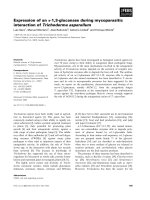
![Tài liệu Báo cáo khoa học: Expression of two [Fe]-hydrogenases in Chlamydomonas reinhardtii under anaerobic conditions doc](https://media.store123doc.com/images/document/14/br/hw/medium_hwm1392870031.jpg)

